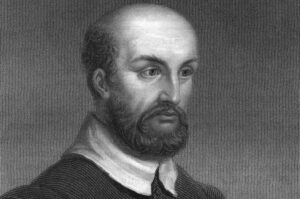Biography of André Palladio

In Padua, Palladio was conceived on November 30, 1508. The man’s father operated a mill. Palladio began his career as a stonecutter at artist Bartolomeo Cavazza da Sossano’s model studio. He was the sacred place’s artist in charge at Padua’s Church of Santa Maria di Carmini.
Palladio relocated to Vicenza at the age of sixteen, where he would spend the most of his life. Here, at the Pedemuro studio—the primary workplace used by stonecutters and other craftspeople—he transformed into a right hand.
Perhaps between 1538 and 1539, the Humanist scholar and writer Gian Giorgio Trissino was making use of the crucial moment that turned Palladio’s career around.
Trissino was From 1538 to 1539.
Recreating the Villa Cricoli, Trissino was grateful for Palladio’s creation. The studies conducted by Vitruvius had a profound effect on Trissino, and Palladio’s own convictions and emotional states were subsequently influenced by them. Being the foremost academic in Vicenza, Trissino strengthened the young man’s appreciation for science, the arts, and classical literature.
Palladio began to develop his architectural style around 1514. Palladio is regarded as one of the most influential architects in Western architecture. According to Watkin, D., A History of Western Architecture, Palladio architectural works have “been esteemed for quite a long time as the core of High Renaissance quiet and concordance.”
Even though Palladio designed churches, palaces, and villas, his fame was built on his ability to build in the role of a villa designer. The majority of Palladian villas can be found in the province of Vicenza, whereas churches are concentrated in Venice and palazzi in the city of Vicenza.
The Palladian Villas of the Veneto and Vicenza, two cities on the World Heritage List, already have some of Palladio’s creations. Within the Venice and Lagoon World Heritage Site are a variety of Palladio buildings.
Palladio’s first major public project began in 1548 with the confirmation of his plans to construct the loggias for the town corridor, or Basilica Palladiana. He suggested using unwritten extents to expand the two-story stone braces in a manner that mirrored the modern lobby’s Gothic design. The construction was completed in 1617 following In addition to his designs, Palladianism benefited by his distributes. Among the many volumes Palladio distributed was I Quattro Libri dell’Architettura, or “The Four Books of Architecture,” published in Venice in 1570. Palladio is mostly well-known and renowned for his publications as well as his designs for estates and regal homes.
He died in 1580
His story was repeated at the convention in Maser, near Treviso, and he was buried in the Santa Corona congregation in Vicenza. His tomb dates from the nineteenth century and is located in the Cimitero, Maggiore in Vicenza, Italy.